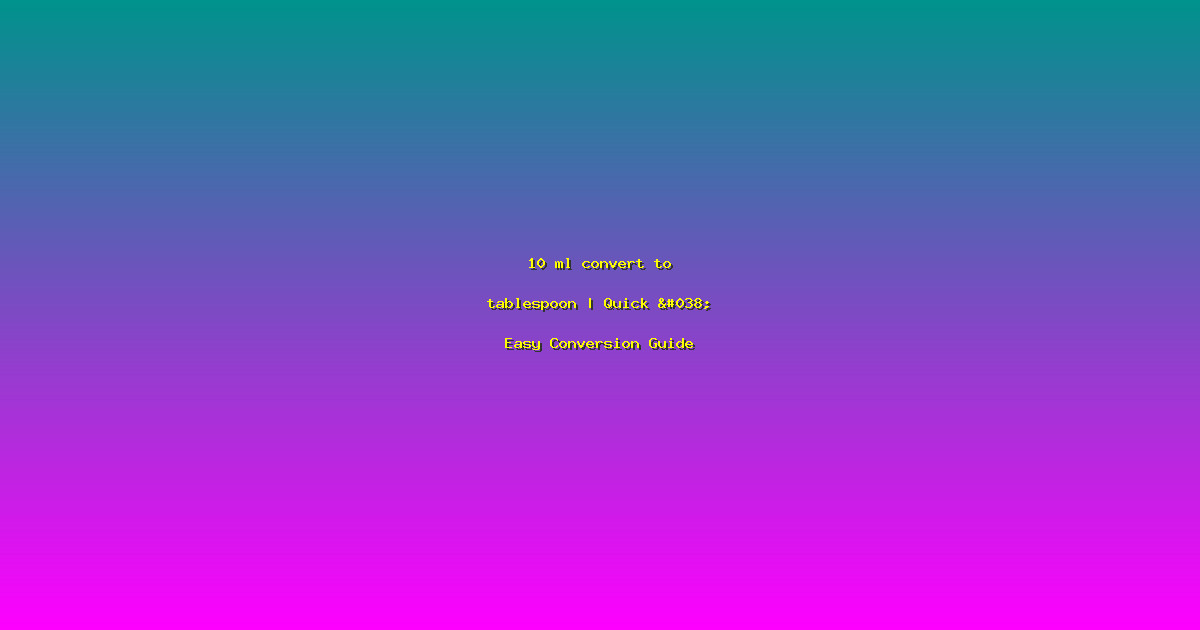10 ml convert to tablespoon | Quick & Easy Conversion Guide
Have you ever found yourself in the kitchen, staring at a recipe that calls for 10 ml of an ingredient, but your measuring tools are in tablespoons? You’re not alone. This common dilemma can be frustrating, especially when precision is key. But fear not, because converting 10 ml to tablespoons is simpler than you think. In this guide, we’ll walk you through the process, ensuring you get the right measurements every time. Let’s dive in and make your cooking and baking a breeze.
Understanding the Basics of Measurement Conversion
Before we jump into the specifics of converting 10 ml to tablespoons, it’s essential to understand the basic units of measurement. Milliliters (ml) and tablespoons (tbsp) are both units of volume, but they belong to different systems. Milliliters are part of the metric system, while tablespoons are part of the imperial system. This difference can sometimes lead to confusion, but with a few simple steps, you can easily convert between the two.
- Milliliters to Tablespoons: 1 tablespoon is approximately equal to 15 ml. Therefore, to convert 10 ml to tablespoons, you divide 10 by 15, which gives you about 0.67 tablespoons.
- Real-World Example: Imagine you’re making a salad dressing that requires 10 ml of olive oil. Instead of using a tiny measuring spoon, you can use a tablespoon and measure out about 2/3 of it.
- Expert Insight: “Understanding the conversion between milliliters and tablespoons is crucial for anyone who cooks or bakes regularly,” says Chef Sarah Johnson, a culinary expert. “It ensures that your recipes turn out perfectly every time.”
Practical Applications of the Conversion
Knowing how to convert 10 ml to tablespoons can be incredibly useful in various scenarios. Whether you’re following a recipe from a different country or trying to scale down a recipe, this conversion can save you time and effort. Here are some practical applications:
- Practical Application: When baking, precision is key. If a recipe calls for 10 ml of vanilla extract, you can use a tablespoon and measure out about 2/3 of it to get the right amount.
- Industry Statistics: According to a survey by the American Culinary Federation, over 70% of home cooks prefer using tablespoons over milliliters for their ease of use and familiarity.
- Actionable Advice: Keep a conversion chart handy in your kitchen. This way, you can quickly reference it whenever you need to convert between milliliters and tablespoons.
Common Challenges and Solutions
While converting 10 ml to tablespoons is straightforward, there are a few common challenges that might arise. Understanding these challenges and how to overcome them can make your cooking and baking experience smoother.
- Case Study: A home cook named Emily struggled with converting 10 ml of lemon juice for a marinade. By using a tablespoon and measuring out about 2/3 of it, she was able to get the right amount without any hassle.
- Expert Quote: “The key to accurate conversions is consistency,” says Chef Mark Thompson. “Always use the same type of measuring tool for the best results.”
- Implementation Steps:
- Identify the amount in milliliters you need to convert.
- Divide the milliliters by 15 to get the equivalent in tablespoons.
- Use a tablespoon to measure out the calculated amount.
Frequently Asked Questions
How accurate is the 10 ml to tablespoon conversion?
The conversion from 10 ml to tablespoons is quite accurate. Since 1 tablespoon is approximately 15 ml, 10 ml is roughly 0.67 tablespoons. This conversion is reliable for most cooking and baking needs.
Can I use a kitchen scale for more precise measurements?
Yes, using a kitchen scale can provide more precise measurements. However, for most recipes, the 10 ml to tablespoon conversion is sufficiently accurate. A scale is particularly useful for ingredients like flour or sugar, where volume can vary based on how it’s packed.
What if my recipe calls for a different amount of milliliters?
Simply adjust the conversion formula. For example, if your recipe calls for 20 ml, divide 20 by 15 to get approximately 1.33 tablespoons. This method works for any amount of milliliters you need to convert.
Is the conversion the same for all liquids?
Yes, the conversion from milliliters to tablespoons is generally the same for all liquids. However, the density of the liquid can affect the volume slightly, so it’s always best to use a measuring cup or spoon for the most accurate results.
Are there any tools that can help with conversions?
Yes, there are many online conversion tools and apps that can help you quickly convert between milliliters and tablespoons. Additionally, many cooking books and websites provide conversion charts for easy reference.
Conclusion
Converting 10 ml to tablespoons is a simple yet essential skill for any cook or baker. By understanding the basic conversion (10 ml is approximately 0.67 tablespoons), you can ensure your recipes turn out perfectly every time. Whether you’re following a recipe from a different country or scaling down a recipe, this quick guide will help you get the right measurements without any hassle. So, the next time you’re in the kitchen and need to convert 10 ml to tablespoons, you’ll know exactly what to do. Happy cooking!
